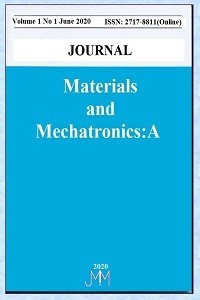Lazer Kaynak Yöntemiyle Birleştirilen Otomotiv Endüstrisinde Kullanılan Farklı Tür Çeliklerin Kaynak Dikiş Geometrisi ve Nüfuziyetine Kaynak Parametrelerinin Etkisi
Lazer kaynağı, Farklı çelik türleri, Nüfuziyet, Mikroyapı, Mekanik özellikler
The Effect of Welding Parameters on Welding Seam Geometry and Penetration of Different Types of Steels Used in Automotive Industry Combined with Laser Welding Method
Laser welding, Different types of steels, Penetration, Microstructure, Mechanical properties,
___
- Aydın K., Karaağaç İ., Lazer kaynağı ve lazer kaynağının başlıca uygulamaları. El-Cezeri Journal of Science and Engineering, 5 (2), 693-705, 2018.
- Calcagnotto M., Adachi Y., Ponge D., Raabe D., Deformation and fracture mechanisms in fine- and ultrafine-grained ferrite/martensite dual-phase steels and the effect of aging. Acta Materialia, 59, 2, 2011.
- Correard G.C.C., Miranda G.P., Lima M.S.F., Development of laser beam welding of advanced high-strength steels. Int J Adv Manuf Technol 83, 1967–1977, 2016.
- Dong D., Liu Y., Yang Y., Li J., Ma M., Jiang T., Microstructure and dynamic tensile behavior of DP600 dual phase steel joint by laser welding. Materials Science and Engineering: A, 594, 17-25, 2013.
- Farabi N., Chen D.L., Li J., Zhou Y., Dong S.J., Microstructure and mechanical properties of laser welded DP600 steel joints. Materials Science and Engineering: A, 527, 4–5, 2010.
- Ferreira C. C., Braga V., Siqueira R. H., Carvalho S. M., Lima Milton S. F., Laser beam welding of DP980 dual phase steel at high temperatures. Optics and Laser Technology, 124, 2020.
- Jokinen T., Novel ways of using Nd: YAG laser for welding thick section austenitic stainless steel. PhD Thesis, Lappeenranta University of Technology, 2004.
- Khan A.S., Baig M., Choi S.H., Yang H.S., Sun X., Quasi-static and dynamicresponses of advanced high strength steels: experiments and modeling. International Journal of Plasticity, 30–31, 1–17, 2012.
- Köse C., Kaçar R., Lazer kaynağı ile birleştirilen AISI 2205 dubleks paslanmaz çeliğin mekanik ve mikroyapı özelliklerinin incelenmesi. Technological Applied Sciences, 11 (4), 98-109, 2016.
- Köse C., Kaçar R., Zorba A.P., Bağırova M., Allahverdiyev A.M., The effect of CO2 laser beam welded AISI 316L austenitic stainless steel on the viability of fibroblast cells, in vitro. Materials Science and Engineering: C, 60, 211-218, 2016.
- Marya, M., Gayden X., Development of requirements for resistance spot welding dual-phase (dp600) steels part 1-the causes of interfacial fracture. Weld Journal, 84 (11), 172-182, 2005.
- Püskülcü G., Koçlular F., Lazer kaynak yöntemi ve uygulaması. Mühendis ve Makine, 599(50), 2009.
- Şen M., Yıldırım E., Çebi H., Özdemir C., Çift fazlı çeliklerden üretilen otomotiv sac parçalarının dizaynında geri esnemeyi optimize edebilmek için sac kalınlığına bağlı olarak büküm radyüslerinin belirlenmesi. Electronic Journal of Machine Technologies, 12(2), 75-95, 2015.
- Taşkın M., Çalıgülü U., Turkmen M., X-Ray tests of AISI 430 and 304 stainless steels and AISI 1010 low carbon steel welded by CO2 laser beam welding. MP-Materials Testing Materials and Components Technology and Application, 53, 741-747, 2011.
- Xu W., Westerbaan D., Nayak S.S., Chen D.L., Goodwin F., Biro E., Zhou Y., Microstructure and fatigue performance of single and multiple linear fiber laser welded DP980 dual-phase steel. Materials Science and Engineering: A, 553, Pages 51-58, 2012.
- Xu W., Westerbaan D., Nayak S.S., Chen D.L., Goodwin F., Biro E., Zhou Y., Tensile and fatigue properties of fiber laser welded high strength low alloy and DP980 dual-phase steel joints Materials & Design, 43, 373-383, 2013.
- Yayın Aralığı: Yılda 2 Sayı
- Başlangıç: 2020
- Yayıncı: Yusuf KAYALI
ROS/Gazebo Ortamında Tank Sürüş Özellikli Mobil Bir Robotun Simülasyonu
Yavuz Bahadır KOCA, Barış GÖKÇE, Yılmaz ASLAN
Borlanmış AISI 316 L Paslanmaz Çeliğin Difüzyon Kinetiğinin İncelenmesi
Mobil Cihazlar için Uygulama Geliştirmekte Kullanılan Platformların ve Dillerin Karşılaştırılması
Sait Mahmut ÇINAR, Hilmi BİLİCİ
Mehmet ÇAKMAKKAYA, Fatih ÇOLAK, Rıza KARA, Adnan KARAAĞAÇLI
Plazma Püskürtme ile Üretilmiş Beyaz ve Gri Al2O3 Kaplamaların Mekanik Özellikleri
